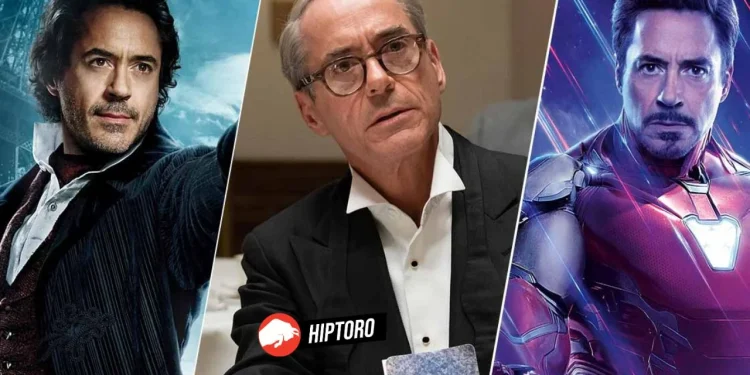Robert Downey Jr.’s journey through the labyrinth of Hollywood fame encapsulates a narrative of resilience, talent, and transformation that is as captivating as the roles he has portrayed on the silver screen. Born on April 4, 1965, in Manhattan, New York, to filmmaker Robert Downey Sr. and actress Elsie Downey, he was introduced to the world of cinema at an early age, making his acting debut at the tender age of five in his father’s film “Pound” (1970). This early exposure to acting paved the way for a career that would be marked by both spectacular highs and well-documented lows.
Downey Jr.’s career in the 1980s and early ’90s was characterized by a series of critically acclaimed performances in films such as “Less Than Zero” (1987), where he played a wealthy drug addict in a role that eerily mirrored his future struggles with substance abuse. However, it was his portrayal of Charlie Chaplin in Richard Attenborough’s “Chaplin” (1992) that earned him an Academy Award nomination for Best Actor, firmly establishing him as a talent of remarkable depth and versatility.
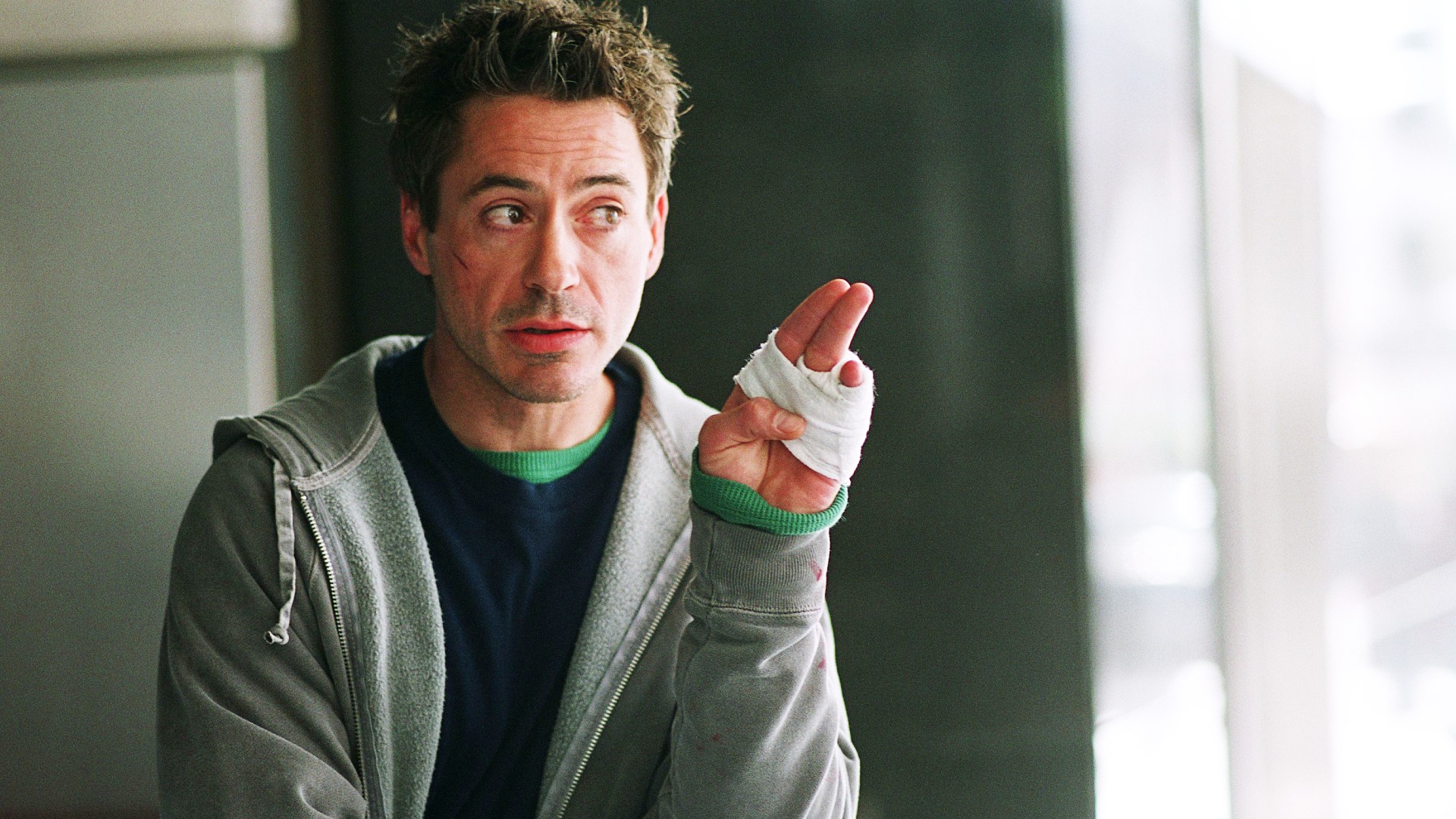
Despite his professional successes, Downey Jr.’s personal life during the late ’90s and early 2000s was mired in legal troubles and substance abuse, leading to multiple arrests and stints in rehab. These challenges threatened to derail his career, casting a long shadow over his undeniable talent. Yet, it was his indomitable spirit and resilience that engineered one of the most extraordinary comebacks in Hollywood history.
In 2008, Downey Jr. was cast as Tony Stark in “Iron Man,” a role that would redefine his career and become synonymous with his name. His portrayal of the charismatic and flawed superhero was pivotal in launching the Marvel Cinematic Universe, a franchise that has become a cornerstone of modern cinema. Downey Jr.’s performances in the MCU, coupled with roles in other major films like “Sherlock Holmes” (2009) and “The Judge” (2014), showcased his ability to imbue his characters with complexity, humor, and humanity.
Off-screen, Downey Jr.’s life reflects a journey of personal growth and redemption. His successful battle with addiction, his advocacy for mental health and sobriety, and his philanthropic efforts contribute to a narrative that extends beyond his cinematic achievements. Married to Susan Levin in 2005, with whom he has two children, Downey Jr. has found stability and contentment in his personal life, further enriching his professional endeavors.
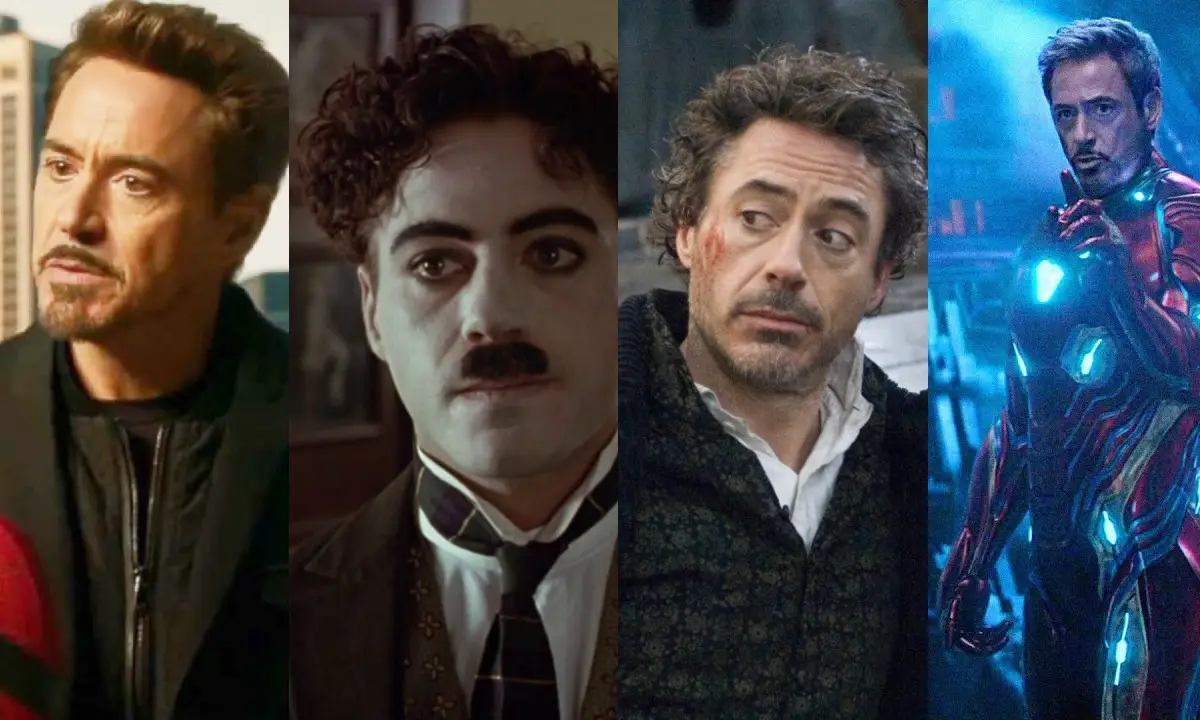
Before diving into detailed analyses of his top films, it’s crucial to understand the criteria for their selection. This list is curated based on a combination of factors, including box office success, critical acclaim, cultural impact, and the depth of Downey Jr.’s performances. His filmography, which spans genres from action-packed superhero epics to heartfelt dramas, showcases his range and adaptability as an actor.
This exploration aims not just to celebrate his most commercially successful films but to highlight the performances that best exemplify his artistic contributions to cinema.
To compile an authoritative and accurate list of Robert Downey Jr.’s top 10 movies, we’ll employ a comprehensive approach, considering box office earnings, critical reviews, audience ratings, and the significance of his role in each film. Given the nature of this task, let’s proceed with identifying these top films.
Top 10 Best Movies of Robert Downey Jr.
1″Iron Man” (2008)
The career of Robert Downey Jr., Directed by Jon Favreau, this film launched the Marvel Cinematic Universe (MCU) and introduced audiences worldwide to Tony Stark, a character that would become synonymous with Downey Jr.’s resurgence as a leading Hollywood star.
The success of “Iron Man” is not just a testament to the film’s compelling narrative, innovative special effects, and dynamic action sequences but also to Downey Jr.’s charismatic and nuanced portrayal of Tony Stark, a flawed genius billionaire turned armored superhero.
At the heart of “Iron Man” is the story of redemption and transformation. Tony Stark, the charismatic yet egotistical inventor and arms dealer, undergoes a profound metamorphosis after a life-threatening incident leads him to reevaluate his life and legacy.
Captured by terrorists and suffering from a severe chest injury, Stark’s ingenuity and will to survive lead him to create the first iteration of the Iron Man suit, setting him on a path toward becoming a force for good. This narrative arc provided Downey Jr. with a rich canvas to showcase his ability to convey complex emotions, from Stark’s initial carelessness and hubris to his growing sense of responsibility and altruism.
Downey Jr.’s performance is characterized by his quick wit, impeccable comedic timing, and the depth he brings to Stark’s character development. His portrayal goes beyond the typical superhero archetype, infusing Stark with relatability and humanity that resonated with audiences.
Robert Downey Jr.’s chemistry with the supporting cast, including Gwyneth Paltrow as Pepper Potts, Terrence Howard as James Rhodes, and Jeff Bridges as Obadiah Stane, further elevates the film, creating a dynamic and engaging ensemble.
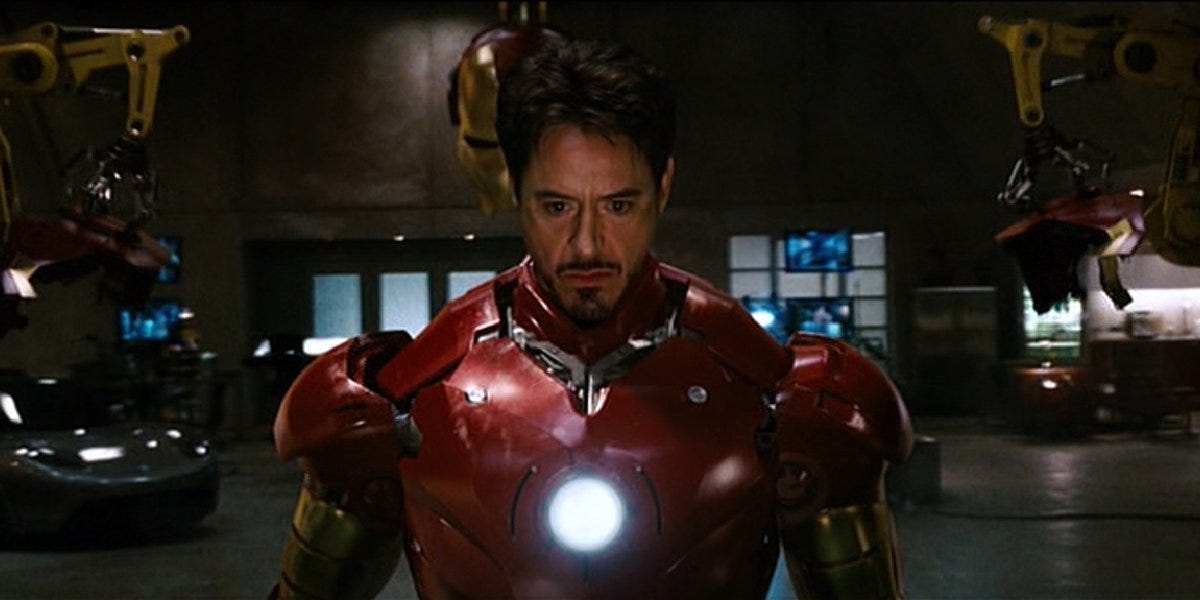
The film’s direction by Jon Favreau and its script, which was notable for allowing Downey Jr. to improvise many of his lines, played to the actor’s strengths, enabling him to imbue Stark with a unique blend of humor, intelligence, and vulnerability. This approach not only set the tone for future MCU films but also established a new template for the superhero genre, one that balances action and spectacle with character-driven storytelling.
Commercially, “Iron Man” was a blockbuster, grossing over $585 million worldwide. It received critical acclaim for its innovative approach to the superhero narrative, its special effects, and particularly for Downey Jr.’s performance, which was widely praised as a career-best. The film’s success laid the groundwork for the expansive MCU, making “Iron Man” not just a movie but a cultural milestone.
In retrospect, “Iron Man” is more than just a comeback vehicle for Robert Downey Jr.; it is a testament to his exceptional talent and versatility as an actor. His embodiment of Tony Stark has become iconic, setting a standard for the portrayal of superheroes on the big screen. The film’s legacy, coupled with Downey Jr.’s performance, continues to influence the genre, making “Iron Man” a seminal work in the canon of superhero cinema.
Through “Iron Man,” Robert Downey Jr. did not just give life to a beloved comic book character; he also embarked on a journey of personal and professional revival, solidifying his status as one of the most talented and enduring actors of his generation. The film’s blend of action, humor, and heart, anchored by Downey Jr.’s charismatic performance, ensures its place as a classic in the annals of cinema history.

Following the monumental success of “Iron Man,” Robert Downey Jr. returned to the silver screen in a role that showcased his versatility as an actor: Sherlock Holmes in the 2009 film directed by Guy Ritchie. This adaptation of Sir Arthur Conan Doyle’s iconic detective brought a fresh, dynamic perspective to the character, blending traditional mystery elements with action-packed sequences and a unique visual style. Downey Jr.’s portrayal of Holmes was both critically acclaimed and beloved by audiences, further cementing his position as one of Hollywood’s most versatile actors.
2. “Sherlock Holmes,” (2009)
Downey Jr. embodies the eccentric detective with unparalleled depth, bringing out the character’s brilliant deductive skills, physical prowess, and complex personality. His Holmes is not just the cerebral, pipe-smoking figure of classic literature but a more rugged, brawling investigator, capable of holding his own in a fistfight as well as outsmarting his adversaries.
This interpretation of Holmes was a departure from previous portrayals, offering a version of the detective that was as physically active as he was intellectually gifted.
The chemistry between Downey Jr. and Jude Law, who played Dr. John Watson, Holmes’s loyal friend and confidant, was another highlight of the film. Their dynamic captured the essence of the Holmes-Watson relationship, marked by camaraderie, mutual respect, and a hint of rivalry. The interplay between Holmes’s brilliant but chaotic approach to solving mysteries and Watson’s more grounded, practical perspective provided the film with its heart and humor.
Guy Ritchie’s direction and the film’s innovative visual style, which included slow-motion sequences that visualized Holmes’s thought process as he planned his moves in physical and intellectual confrontations, complemented Downey Jr.’s performance. These elements combined to create a thrilling, engaging cinematic experience that breathed new life into the Sherlock Holmes franchise.
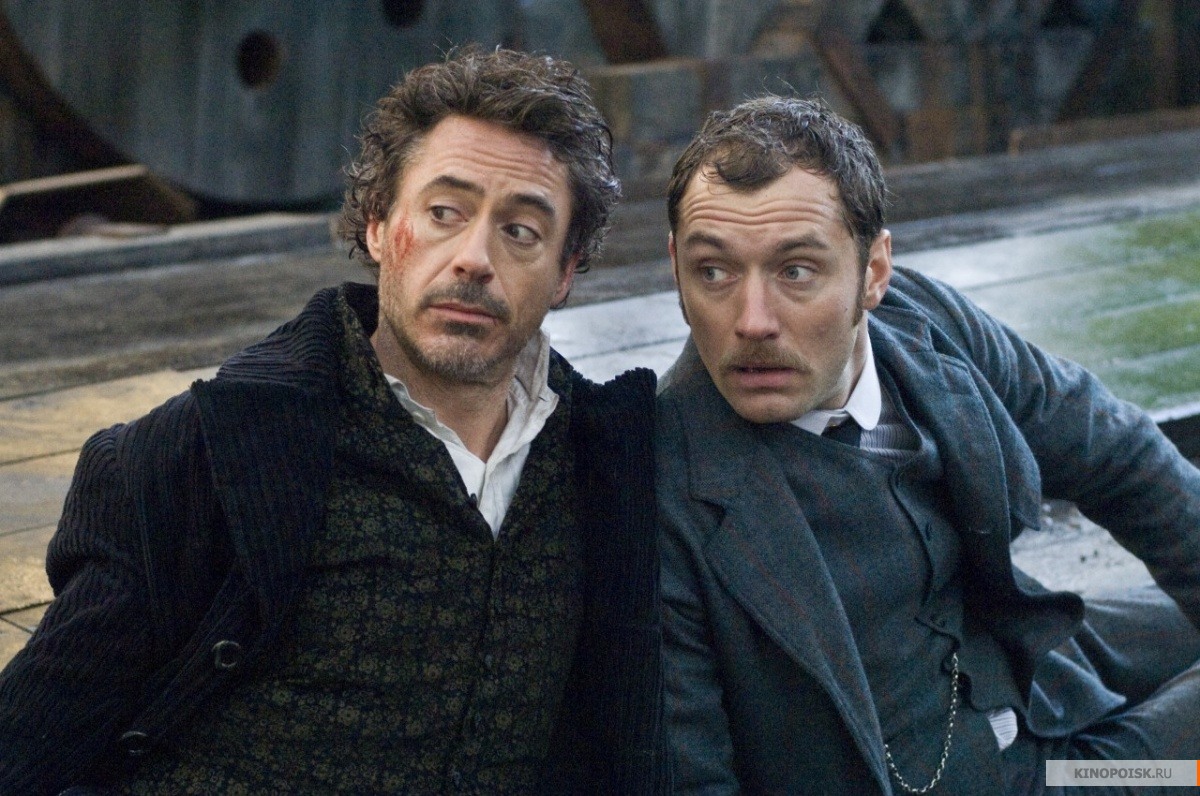
Commercially, “Sherlock Holmes” was a success, grossing over $524 million worldwide. It received praise for its reimagining of the titular character, the performances of the cast, and its action sequences. The film’s success led to a sequel, “Sherlock Holmes: A Game of Shadows,” which further explored the Holmes-Watson dynamic and Holmes’s confrontation with his greatest adversary, Professor Moriarty.
Robert Downey Jr.’s portrayal of Sherlock Holmes is a testament to his skill in bringing complex characters to life. He infused Holmes with a multifaceted personality, combining intelligence, wit, vulnerability, and physicality in a way that resonated with modern audiences while staying true to the spirit of Conan Doyle’s work. His performance in “Sherlock Holmes” not only provided a fresh take on the character but also showcased Downey Jr.’s range as an actor, proving that he could captivate audiences beyond his role as Tony Stark/Iron Man.

The impact of “Sherlock Holmes” extends beyond its box office success and critical acclaim; it reinvigorated interest in the detective genre and introduced Sherlock Holmes to a new generation of fans. Downey Jr.’s portrayal remains one of the most memorable and distinctive interpretations of the character, highlighting his ability to transform and adapt to different roles, further establishing him as one of the most talented actors of his time.
3. “Avengers: Endgame” (2019) – The Culmination of a Saga
“Avengers: Endgame” is not merely a film; it is an epochal event in the annals of cinema, representing the culmination of over a decade of storytelling within the Marvel Cinematic Universe (MCU). Released in 2019 and directed by Anthony and Joe Russo, “Endgame” serves as a direct sequel to “Avengers: Infinity War” (2018), offering a resolution to the devastating events that left the universe in shambles and fans in eager anticipation.
At the heart of this cinematic juggernaut is Robert Downey Jr.’s Tony Stark/Iron Man, whose journey from a self-absorbed genius to a self-sacrificing hero forms the emotional backbone of the MCU.
“Endgame” begins in the aftermath of Thanos’s victory, with the remaining Avengers grappling with their failure and the loss of half of all life in the universe. The narrative is a complex tapestry of time travel, epic battles, and personal redemption arcs, with Stark’s story being particularly poignant.
Robert Downey Jr. delivers a performance that is both nuanced and powerful, capturing the essence of Stark’s internal conflict, his fears, and his unwavering resolve to rectify his past mistakes, no matter the personal cost.
The film’s narrative structure allows for a deep exploration of Stark’s character, showcasing his ingenuity, bravery, and growth. Downey Jr.’s portrayal of Stark’s vulnerability and determination adds depth to the character, making his final act of self-sacrifice a profoundly moving moment.
This scene, where Stark uses the Infinity Stones to defeat Thanos at the cost of his own life, is a testament to Downey Jr.’s ability to convey complex emotions, leaving an indelible mark on audiences worldwide.
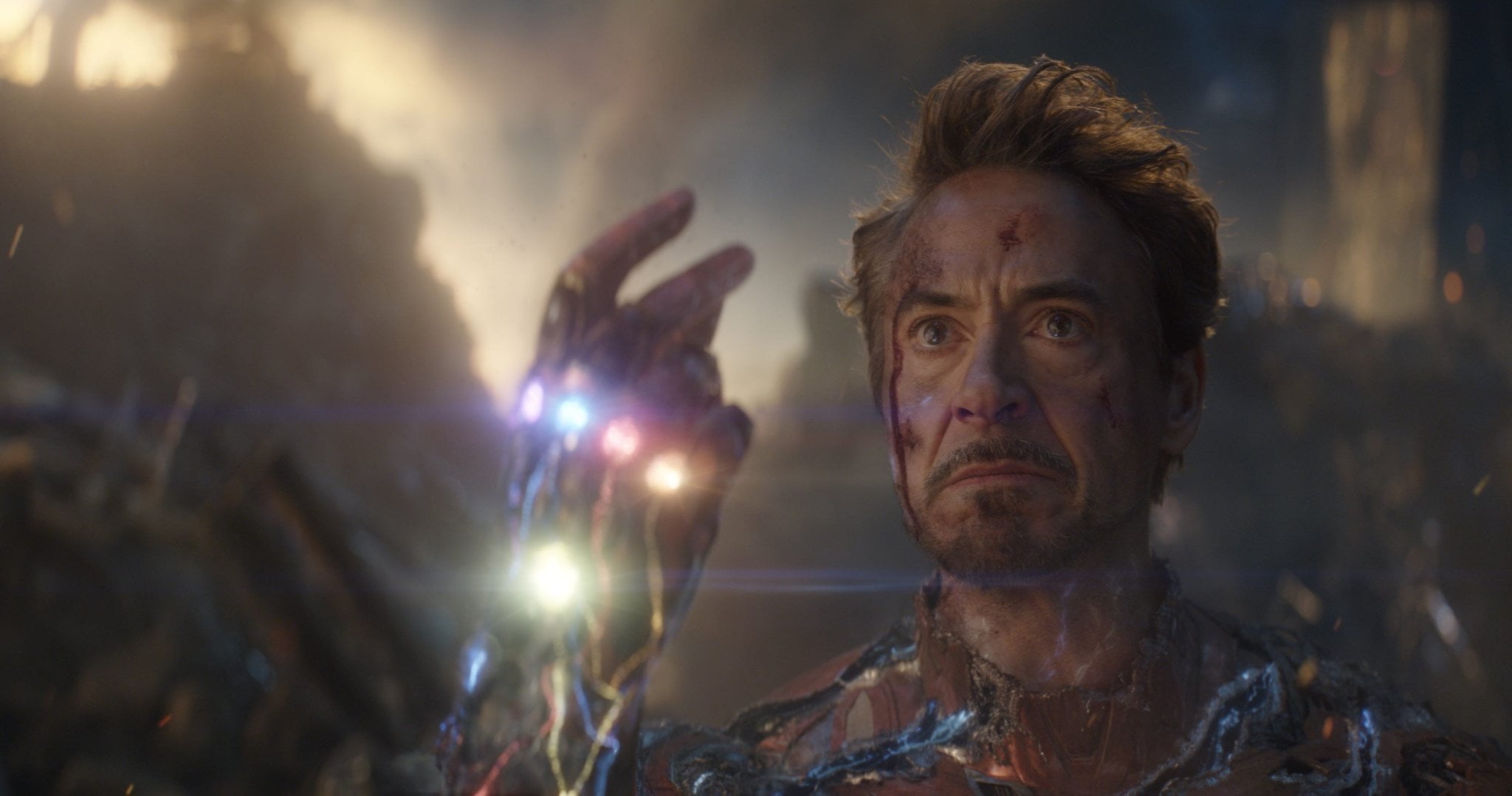
“Avengers: Endgame” is also a celebration of the MCU’s expansive universe, bringing together a vast array of characters in a fight against a common enemy. However, it is Stark’s journey, so brilliantly encapsulated by Downey Jr., that stands as the film’s emotional core. His performance elevates the movie, ensuring that Stark’s legacy is felt throughout the fabric of the MCU.
Commercially, “Endgame” shattered box office records, becoming the highest-grossing film of all time until it was surpassed by the re-release of “Avatar” (2009). Critics praised the film for its direction, visual effects, and emotional weight, with particular accolades for Downey Jr.’s performance. His role in “Endgame” is a fitting farewell to a character that he has inhabited for over a decade, providing a satisfying conclusion to Tony Stark’s arc.

In reflecting on “Avengers: Endgame,” it is clear that the film is a monumental achievement in storytelling and visual spectacle. Robert Downey Jr.’s portrayal of Tony Stark/Iron Man is central to its impact, offering a masterclass in character development and emotional storytelling. “Endgame” is not just a testament to the power of cinema to entertain but also to inspire and evoke deep emotional responses. It stands as a tribute to the journey of its characters and the actors who brought them to life, with Downey Jr.’s performance as Stark being a cornerstone of its legacy.
4. “Iron Man 3” (2013) – A Deep Dive into the Psyche of Tony Stark
“Iron Man 3,” released in 2013 and directed by Shane Black, represents a pivotal chapter in the Marvel Cinematic Universe (MCU), focusing on the psychological aftermath Tony Stark faces following the events of “The Avengers” (2012).
This film delves into Stark’s vulnerabilities, exploring themes of trauma, identity, and resilience, set against a backdrop of high-stakes action and technological innovation. Robert Downey Jr.’s performance in this installment is particularly noteworthy as he navigates Stark’s journey from a man haunted by his experiences to one who discovers the true essence of his heroism lies not in his Iron Man suit but in his humanity.
The narrative of “Iron Man 3” is propelled by Stark’s struggle with post-traumatic stress disorder (PTSD), a consequence of his near-death experience during the Battle of New York. Downey Jr. portrays this aspect of Stark with depth and sensitivity that adds layers to the character, showcasing his ability to handle dramatic material with nuance. Stark’s vulnerability is juxtaposed against the backdrop of a new threat in the form of the Mandarin, a terrorist leader whose actions lead Stark on a path of self-discovery and redemption.
One of the film’s strengths lies in its exploration of Stark’s character, stripping away the armor both literally and metaphorically to reveal the man beneath. Downey Jr.’s performance is central to this narrative arc, as he embodies Stark’s wit, intelligence, and determination while also conveying his fears and insecurities. This multifaceted portrayal ensures that Stark remains a relatable and compelling figure, even as he faces extraordinary challenges.
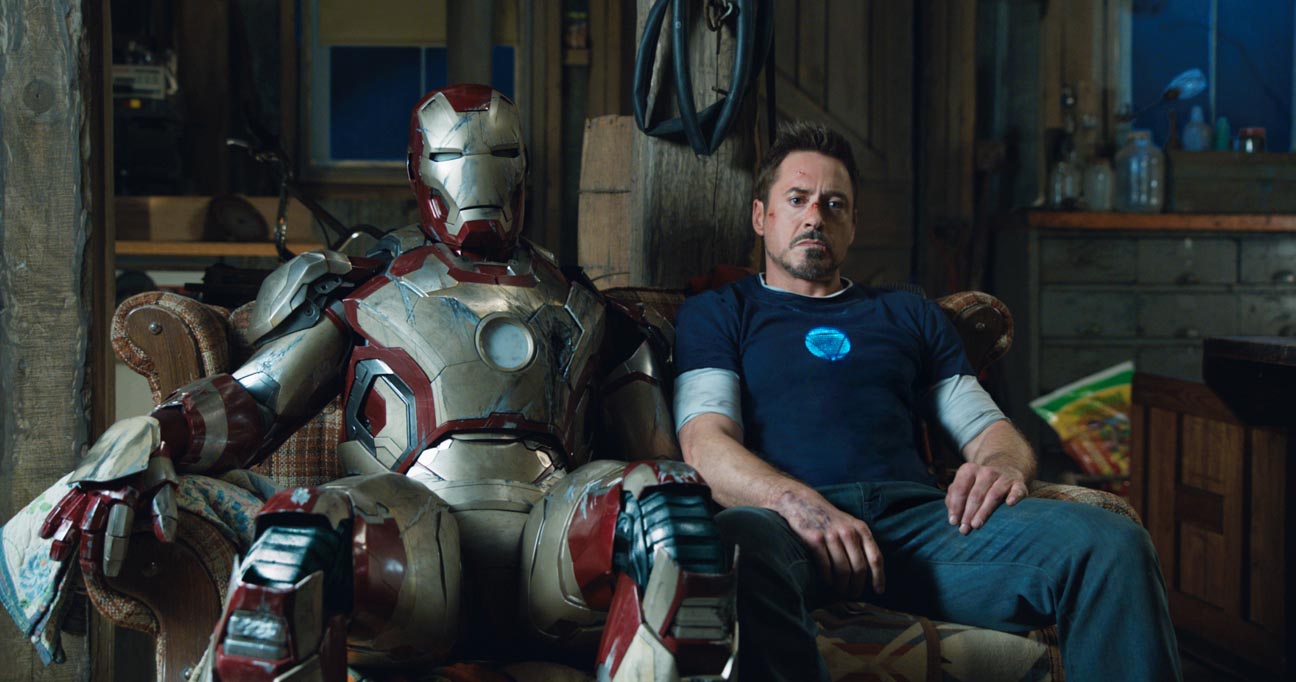
“Iron Man 3” also stands out for its action sequences, which are both visually spectacular and integral to the film’s exploration of Stark’s character. The destruction of Stark’s Malibu home and the climactic battle involving multiple Iron Man suits are highlighted, showcasing the film’s innovative special effects and Downey Jr.’s ability to anchor these larger-than-life moments with emotional weight.
Commercially, “Iron Man 3” was a box office success, grossing over $1.2 billion worldwide. It received positive reviews from critics, who praised its character-driven approach, action sequences, and Downey Jr.’s performance. The film’s success reaffirmed Stark’s status as a cornerstone of the MCU and demonstrated the enduring appeal of Downey Jr.’s portrayal.

In conclusion, “Iron Man 3” is a testament to the complexity and depth of Tony Stark as a character, largely due to Robert Downey Jr.’s nuanced performance. The film skillfully balances action and character development, offering a compelling exploration of heroism, identity, and resilience. Downey Jr.’s portrayal of Stark’s journey from vulnerability to strength is both inspiring and relatable, making “Iron Man 3” a standout entry in the MCU and a significant chapter in the evolution of one of cinema’s most iconic characters.
5. “Tropic Thunder” (2008) – A Satirical Tour de Force
“Tropic Thunder,” directed by Ben Stiller and released in 2008, is a satirical action comedy that delves into the absurdities of Hollywood and the filmmaking process. Set against the backdrop of a war movie production gone awry, the film features an ensemble cast including Stiller, Jack Black, and Robert Downey Jr., who delivers one of his most daring and controversial performances.
As Kirk Lazarus, an Australian method actor who undergoes a controversial “pigmentation alteration” procedure to play a black character, Downey Jr. showcases his exceptional range and fearlessness as an actor.
Downey Jr.’s portrayal of Lazarus is a nuanced satire of method acting and Hollywood’s racial insensitivities. The character, who refuses to break character until the DVD commentary, is both a critique and a comedic highlight, with Downey Jr. navigating the fine line between satire and offense with remarkable skill. His performance is a testament to his versatility, demonstrating his ability to inhabit drastically different roles and genres.
“Tropic Thunder” is notable for its bold commentary on the entertainment industry, lampooning everything from actor egos and studio politics to the exploitation of real-life conflicts for cinematic spectacle.
The film’s meta-narrative, which includes actors playing actors lost in the jungles of Southeast Asia during the shooting of a war movie, allows for a layered exploration of reality versus fiction.
Robert Downey Jr.’s character, constantly oscillating between his real identity and the persona he adopts for the film-within-a-film, embodies this theme, offering a critique of the lengths to which actors will go for their craft.
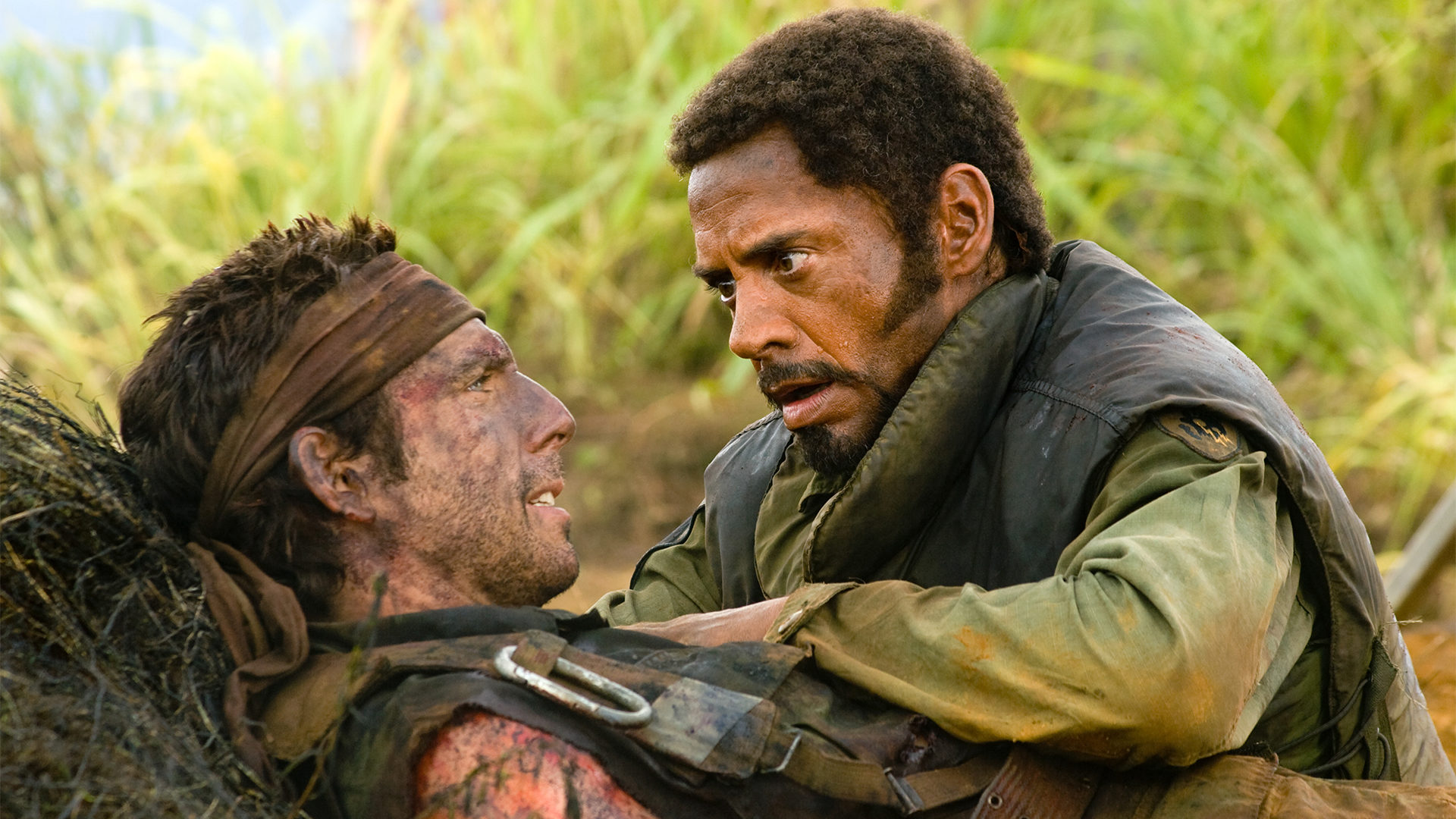
The film received critical acclaim for its sharp satire, dynamic performances, and audacious humor. Downey Jr.’s role, in particular, was highlighted as a standout, earning him an Academy Award nomination for Best Supporting Actor. This nod from the Academy recognized not only the complexity of his performance but also the film’s clever subversion of cinematic norms.
Commercially, “Tropic Thunder” was a success, resonating with audiences for its irreverent take on Hollywood and the boldness of its humor. The film’s ability to balance comedy with a critical examination of the film industry is a testament to the talents of its cast and crew, with Downey Jr.’s performance exemplifying the movie’s daring approach.
In retrospect, “Tropic Thunder” remains a significant work in Downey Jr.’s filmography, highlighting his comedic prowess and his willingness to take on challenging and unconventional roles. His portrayal of Kirk Lazarus is a masterclass in comedic timing, character immersion, and satirical commentary, contributing to the film’s lasting impact as a critique of Hollywood’s excesses and eccentricities.

Through “Tropic Thunder,” Robert Downey Jr. once again proved his exceptional versatility as an actor, capable of moving seamlessly between genres and delivering performances that challenge, entertain, and provoke thought. His role in the film is a reminder of the power of cinema to reflect and satirize societal norms, with Downey Jr.’s contribution standing as a bold statement on the complexities of performance, identity, and representation in contemporary film.
6. “Captain America: Civil War” (2016) – Ideological Battles and Personal Demons
“Captain America: Civil War,” directed by Anthony and Joe Russo and released in 2016, stands as a pivotal film within the Marvel Cinematic Universe (MCU). It is not just a superhero movie; it’s a complex narrative about friendship, ideology, and the consequences of power.
Robert Downey Jr. reprises his role as Tony Stark/Iron Man, delivering a performance that underscores the depth and complexity of his character amidst a fracturing Avengers team. This film is particularly significant as it explores the ideological divide between Stark and Steve Rogers/Captain America, portrayed by Chris Evans, setting the stage for a conflict that is deeply personal and universally resonant.
The premise of “Civil War” revolves around the Sokovia Accords, a legislative bill aimed at regulating the actions of superheroes. Stark, carrying the weight of guilt from previous battles that resulted in collateral damage, supports government oversight.
In contrast, Rogers believes in the autonomy of the Avengers to act without government intervention. This ideological clash forms the crux of the film, leading to an internal war among the Avengers. Downey Jr.’s portrayal of Stark in this conflict is nuanced, capturing the character’s internal struggle between his rational understanding of the need for control and his emotional ties to his fellow Avengers.
Downey Jr.’s performance is pivotal in conveying the gravity of the situation. His ability to depict Stark’s vulnerability, guilt, and determination adds layers to the narrative, making the conflict not just about superhero politics but also about personal redemption, responsibility, and the cost of making hard decisions.
The film’s action sequences, while visually spectacular, are underscored by these personal stakes, with the battle at the airport being a highlight, showcasing the physical manifestation of the ideological divide.
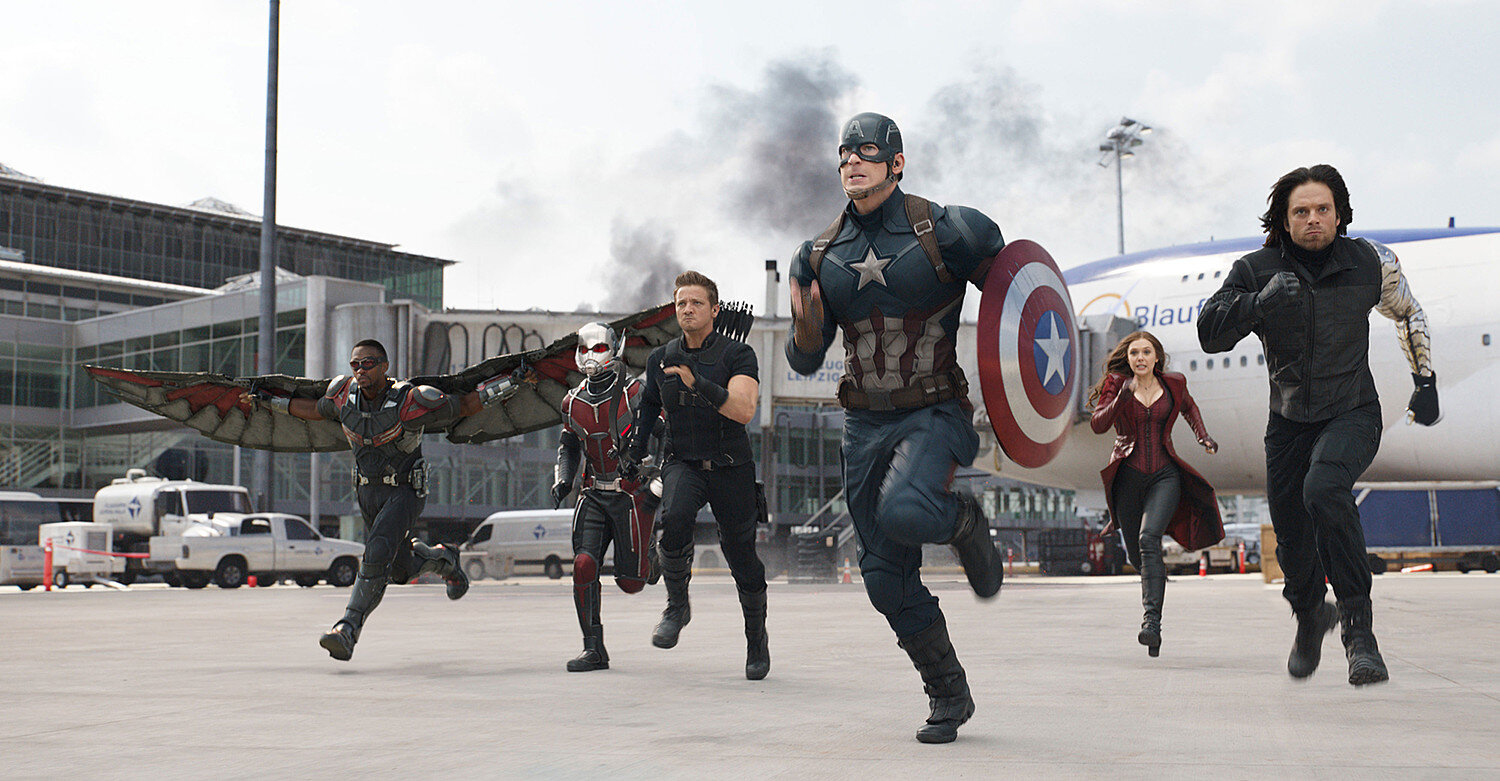
“Civil War” also delves into Stark’s demons, particularly through his interactions with Rogers and Bucky Barnes/The Winter Soldier (Sebastian Stan). Downey Jr.’s chemistry with Evans and Stan adds depth to their confrontations, elevating the narrative from a mere superhero showdown to a poignant exploration of friendship, betrayal, and the shades of grey in between.
Commercially, “Captain America: Civil War” was a box office success, grossing over $1.1 billion worldwide. It received critical acclaim for its sophisticated storytelling, character development, and the way it effectively balanced a large ensemble cast, with Downey Jr.’s performance standing out as a cornerstone of the film’s emotional impact.

In retrospect, “Captain America: Civil War” is a testament to the MCU’s ability to blend action, character, and thematic depth, with Robert Downey Jr.’s Tony Stark/Iron Man at the heart of this achievement. His portrayal in this film encapsulates the evolution of Stark from a self-centered genius to a conflicted hero grappling with the consequences of his actions. Downey Jr.’s nuanced performance ensures that Stark remains a compelling and relatable figure, showcasing the actor’s profound impact on the MCU and solidifying “Civil War” as a critical and commercial triumph.
7. “Sherlock Holmes: A Game of Shadows” (2011) – A Dynamic Sequel of Wit and Intrigue
“Sherlock Holmes: A Game of Shadows,” directed by Guy Ritchie, is the second installment in the Sherlock Holmes series starring Robert Downey Jr. as the eponymous detective.
Released in 2011, the film builds on the success of its predecessor by delving deeper into the complex relationship between Holmes and his arch-nemesis, Professor James Moriarty, portrayed with chilling precision by Jared Harris. This sequel not only showcases Downey Jr.’s continued mastery in the role of Holmes but also elevates the franchise’s blend of action, humor, and mystery.
The film’s plot revolves around Holmes and Dr. John Watson, played by Jude Law, as they embark on a cross-European adventure to thwart Moriarty’s diabolical plot to instigate a world war for personal gain. Downey Jr.’s portrayal of Holmes is as charismatic and eccentric as ever, embodying the detective’s unparalleled intellect and physical prowess.
His performance, coupled with Ritchie’s dynamic direction, ensures that Holmes’s deductive brilliance and penchant for disguise are on full display, providing audiences with a thrilling and visually captivating experience.
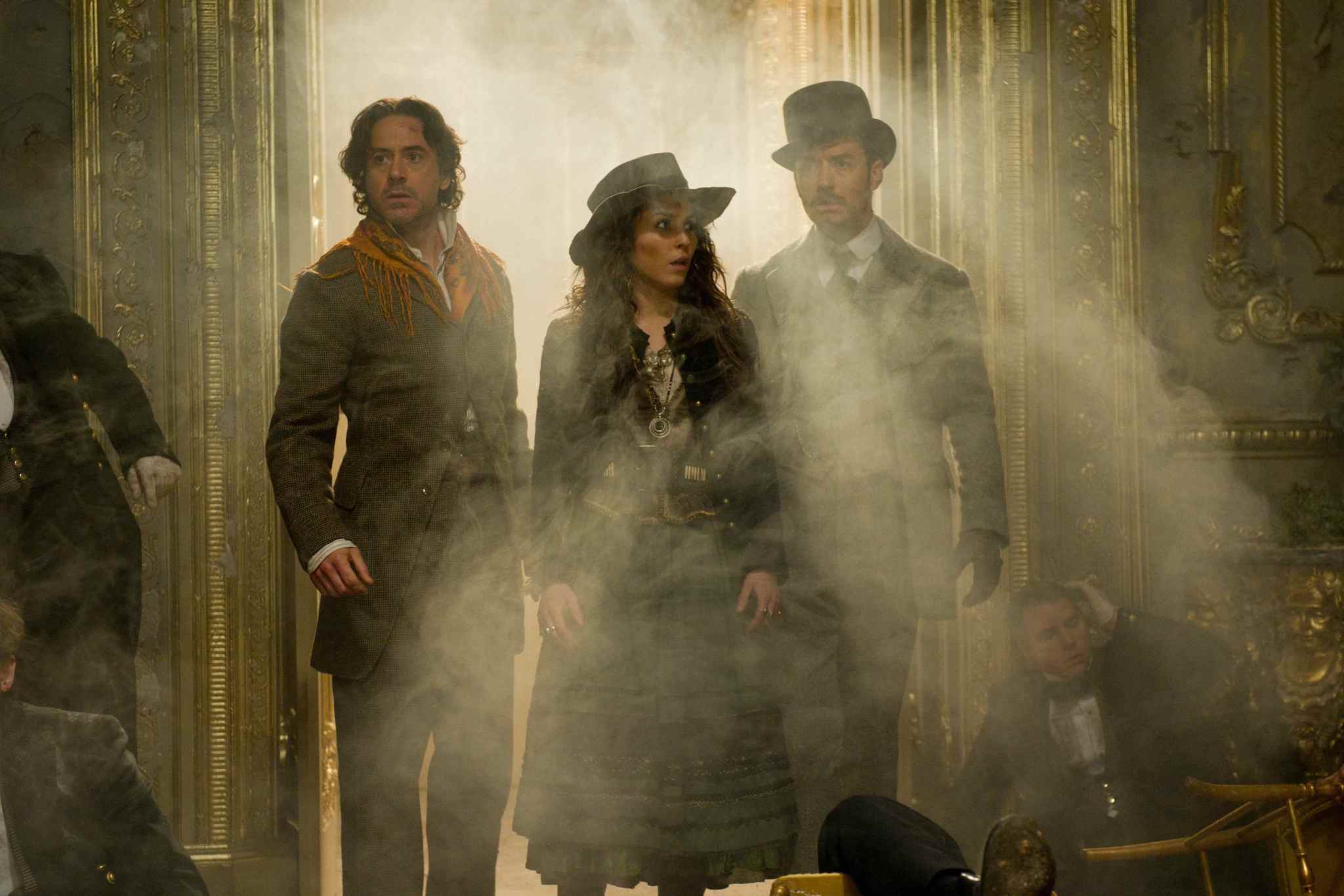
What sets “A Game of Shadows” apart is its focus on the cerebral battle between Holmes and Moriarty. Downey Jr. and Harris’s on-screen chemistry is electric, offering a compelling depiction of their intellectual rivalry.
The film’s climax, a chess match intercut with scenes of impending disaster, serves as a metaphor for their battle of wits, highlighting Downey Jr.’s ability to convey intense concentration and determination.
The relationship between Holmes and Watson also receives significant attention, with Downey Jr. and Law further developing their characters’ brotherly bond. Their interactions provide much of the film’s heart and humor, showcasing Downey Jr.’s versatility in balancing action-packed sequences with moments of genuine emotion and comedic relief.
Commercially, “Sherlock Holmes: A Game of Shadows” was a success, earning praise for its action sequences, visual style, and the performances of its leads. Downey Jr.’s role was particularly lauded, affirming his status as a definitive portrayal of the iconic detective.

In conclusion, “Sherlock Holmes: A Game of Shadows” is a testament to Robert Downey Jr.’s talents as an actor, capable of imbuing a well-known character with new life. His performance, combined with the film’s engaging plot and visual flair, cements this sequel as a worthy addition to the Holmes canon.
Robert Downey Jr.’s dynamic portrayal of Sherlock Holmes showcases his range and commitment to character, making “A Game of Shadows” a memorable and entertaining cinematic experience.
8. “The Judge” (2014) – A Courtroom Drama Meets Emotional Family Saga
“The Judge,” directed by David Dobkin, represents a pivot in Robert Downey Jr.’s career towards more dramatic and emotionally charged roles. Released in 2014, the film pairs Downey Jr. with Robert Duvall in a story that blends legal drama with a complex father-son relationship set against the backdrop of a small-town courtroom.
Robert Downey Jr. plays Hank Palmer, a successful big-city lawyer who returns to his hometown for his mother’s funeral and is confronted with his estranged relationship with his father, Judge Joseph Palmer, portrayed by Duvall.
Downey Jr.’s performance in “The Judge” is a showcase of his versatility as an actor, demonstrating his ability to convey deep emotional turmoil and vulnerability. The character of Hank Palmer requires Downey Jr. to navigate a spectrum of emotions, from the arrogance of a defense attorney confident in his ability to manipulate the law to the repressed pain of a son seeking approval and reconciliation with his father. His portrayal is nuanced, balancing the character’s sharp wit with moments of sincere introspection and regret.
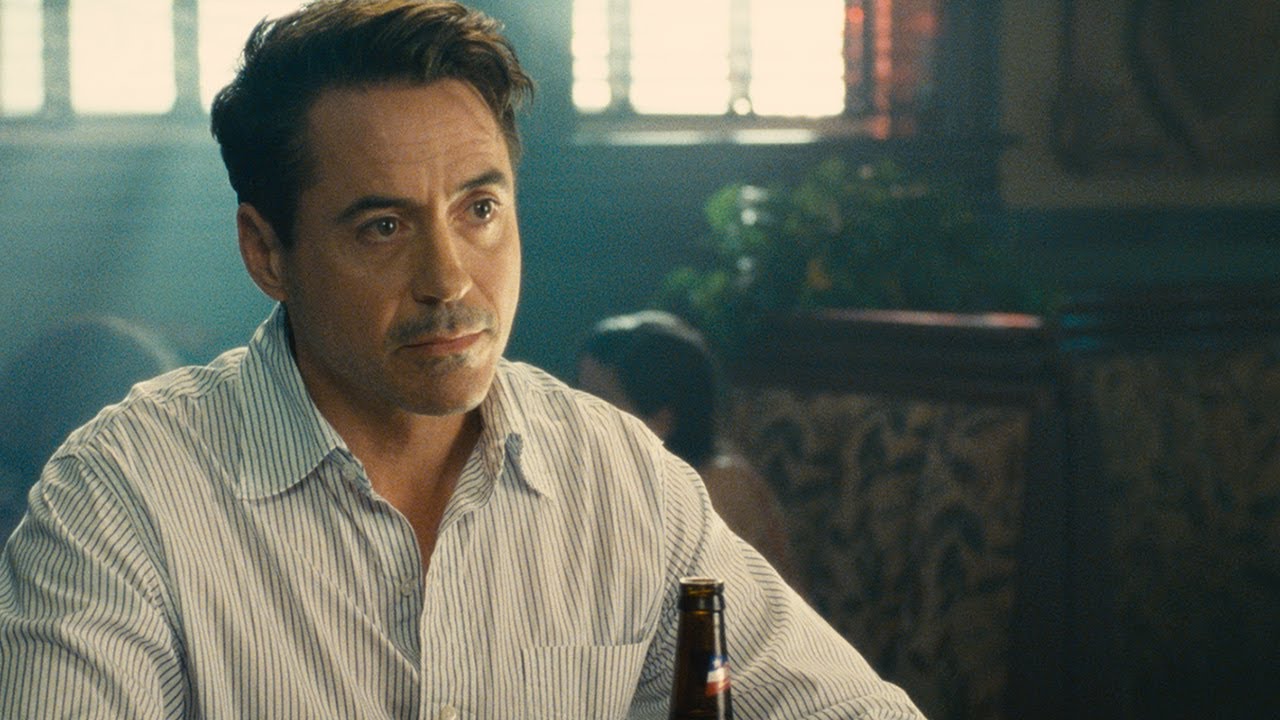
The film’s narrative centers around the death of a local man with whom the judge had a contentious history, leading to Joseph Palmer being accused of murder. As Hank delves into the case, he also begins to unearth the family secrets and personal demons that have long distanced him from his father and brothers.
The courtroom scenes provide a stage for Downey Jr.’s dynamic performance, but it’s the off-court interactions, filled with familial tensions and unresolved grievances, that truly highlight his acting prowess.
“The Judge” received mixed reviews from critics, who praised the performances of Downey Jr. and Duvall but critiqued the film for its predictability and sentimentalism.
Despite this, the film was a critical moment for Downey Jr., allowing him to step away from the larger-than-life characters of Tony Stark and Sherlock Holmes to portray a man wrestling with the complexities of family and forgiveness.

Commercially, “The Judge” performed modestly at the box office, but it served as a critical piece in Downey Jr.’s filmography, demonstrating his capacity for roles that demand a deep emotional resonance. His chemistry with Duvall is particularly noteworthy, with both actors delivering performances that elevate the narrative, making “The Judge” a compelling exploration of the bonds that both unite and divide families.
9. “Iron Man 2” (2010) – Navigating Fame, Legacy, and Vulnerability
“Iron Man 2,” directed by Jon Favreau, is the third film in the Marvel Cinematic Universe (MCU) and serves as a direct sequel to the groundbreaking “Iron Man” (2008). Released in 2010, the film finds Tony Stark grappling with the repercussions of his public identity as Iron Man, including government pressure to share his technology, rivalry with other industrialists, and a new, formidable adversary in Ivan Vanko/Whiplash, portrayed by Mickey Rourke. Robert Downey Jr.’s return to the role of Stark is marked by his signature blend of wit, depth, and vulnerability as he navigates the complexities of heroism, legacy, and mortality.
At the core of “Iron Man 2” is Stark’s struggle with his own mortality, a theme introduced through his battle with palladium poisoning, a side effect of the arc reactor that keeps him alive and powers the Iron Man suit.
Robert Downey Jr. adeptly portrays Stark’s recklessness in the face of his deteriorating health, his efforts to secure his legacy through the Stark Expo, and his eventual realization of the need for allies and transparency. This emotional journey adds layers to Stark’s character, moving beyond the confident playboy genius to reveal a man facing his limitations and responsibilities.
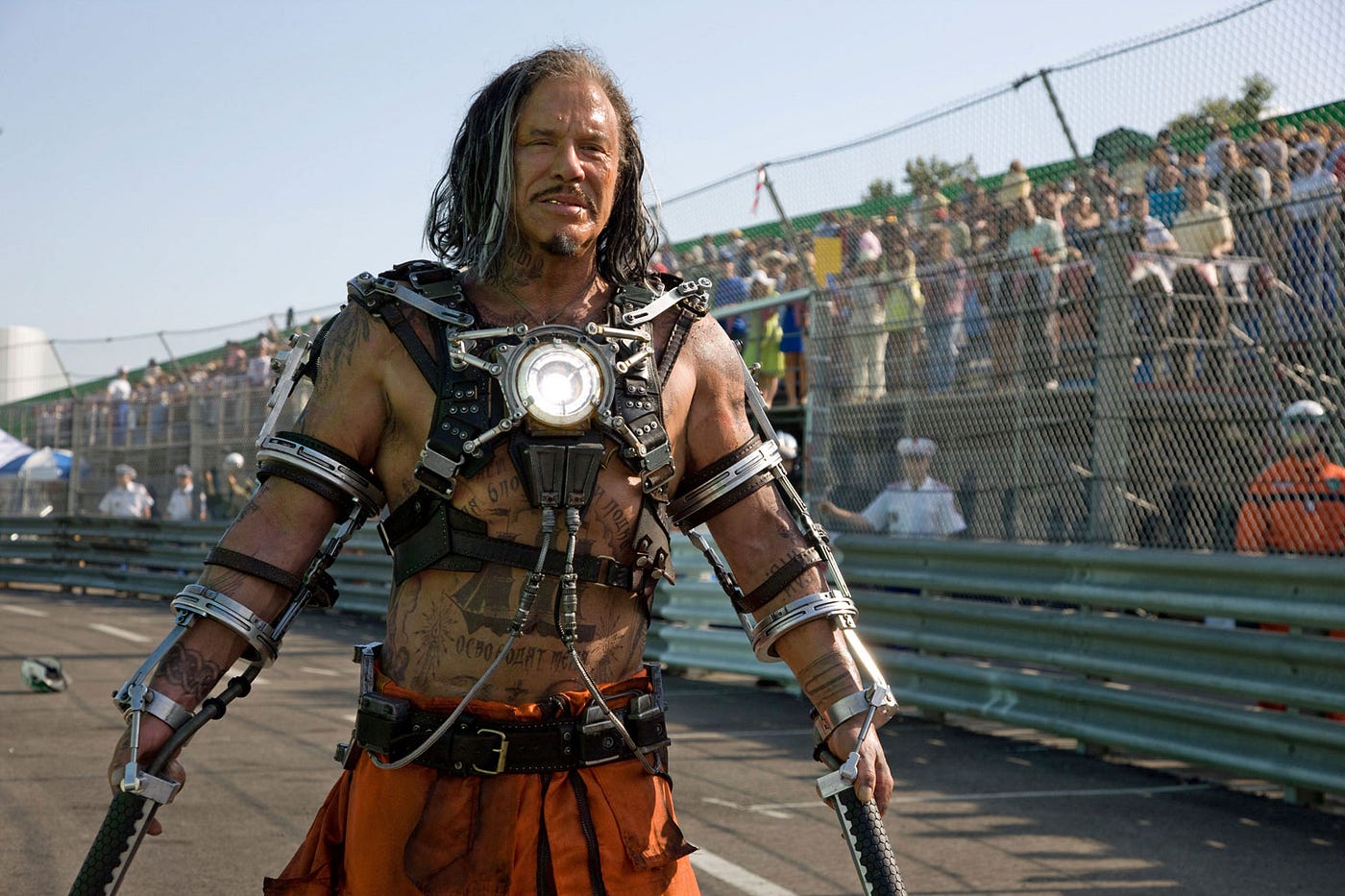
The film expands the MCU by introducing new characters, including Natasha Romanoff/Black Widow (Scarlett Johansson) and Nick Fury (Samuel L. Jackson), and deepening the relationship between Stark and Pepper Potts (Gwyneth Paltrow). Downey Jr.’s chemistry with the ensemble cast enriches the narrative, offering moments of humor, tension, and growth that underscore Stark’s evolution as both a hero and a man.
While “Iron Man 2” faced criticism for its pacing and perceived role as a setup for future MCU films, Downey Jr.’s performance was widely praised. His ability to convey Stark’s charisma, intelligence, and vulnerability ensures that the character remains engaging and relatable, even amidst the film’s action sequences and broader franchise-building efforts.

Commercially, “Iron Man 2” was a success, further cementing the Iron Man franchise as a cornerstone of the MCU and Downey Jr. as one of its most beloved stars. The film’s exploration of themes such as legacy, accountability, and the cost of innovation resonates within the larger context of superhero narratives, offering a nuanced take on the challenges of being a hero in a complex world.
10. “Chaplin” (1992) – A Masterclass in Character Transformation
Directed by Richard Attenborough, “Chaplin” is a biographical film that chronicles the life and times of Charlie Chaplin, from his humble beginnings in London to his rise as one of the most influential figures in the history of cinema.
Robert Downey Jr.’s portrayal of Chaplin is a tour de force, demonstrating an exceptional range of acting skills that capture the essence of the legendary filmmaker, actor, and composer. Downey Jr. not only embodies Chaplin’s physical mannerisms and comedic style but also delves deep into the emotional and psychological complexities of the man behind the screen persona.
“Chaplin” presented Downey Jr. with the challenge of portraying a character across a wide span of his life, from his early 20s to his old age. Through meticulous preparation and undeniable talent, Downey Jr. convincingly navigates Chaplin’s evolution, capturing his initial success, the controversies that marred his career, his political and social activism, and his eventual exile from the United States.
The performance is marked by a profound depth of emotion, from the highs of Chaplin’s creative genius and personal triumphs to the lows of his personal struggles and professional battles.
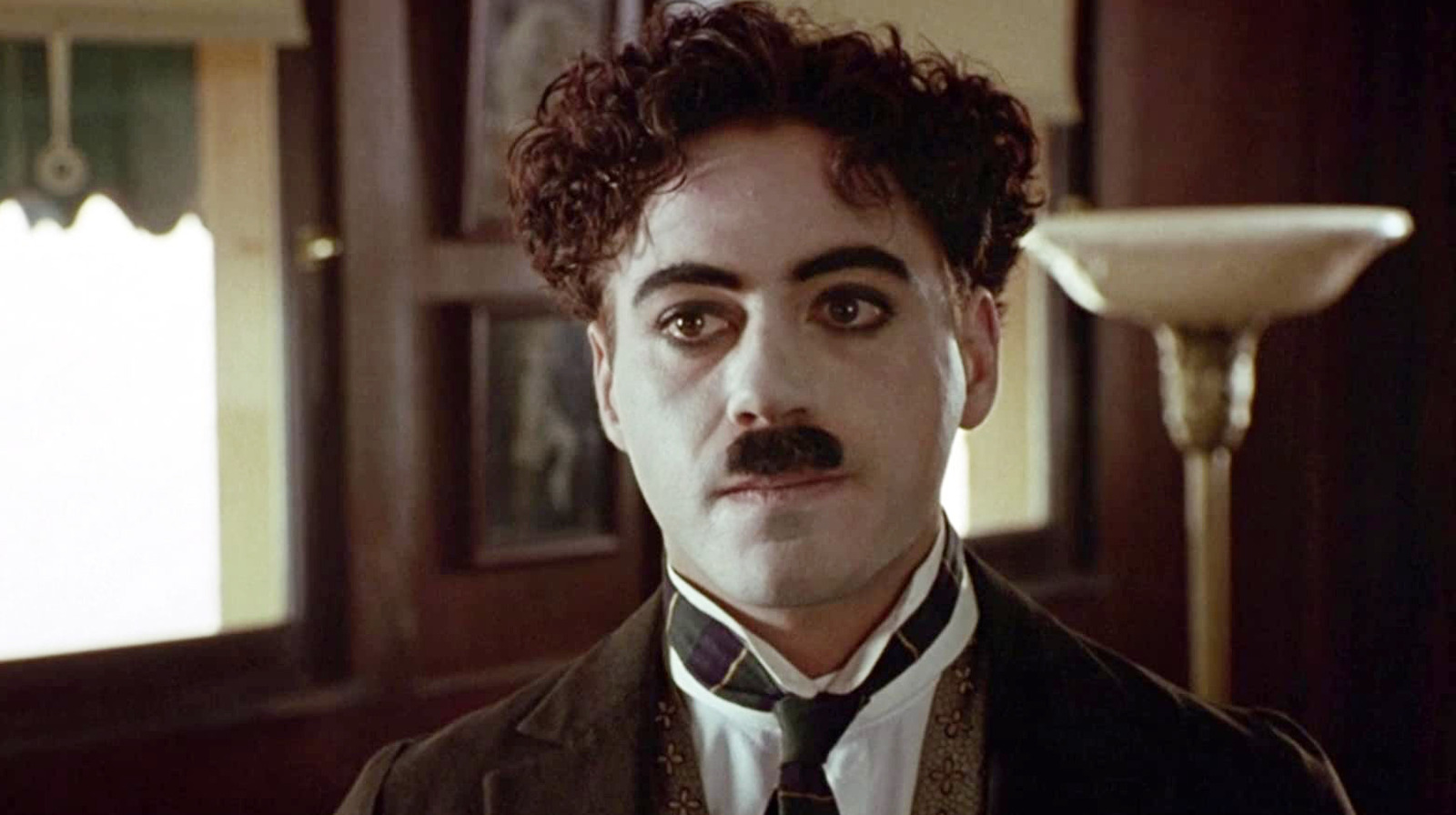
Downey Jr.’s performance was critically acclaimed, earning him an Academy Award nomination for Best Actor. His ability to bring nuance and authenticity to the role was particularly noted, showcasing his capacity for dramatic roles and his dedication to his craft. The film itself offers a rich tapestry of early Hollywood, providing insight into the industry’s evolution while focusing on the personal and creative journey of one of its most enduring icons.
Commercially, “Chaplin” was more modest in its success compared to the blockbuster hits of Downey Jr.’s later career. However, the film’s impact on his career trajectory cannot be overstated. It marked a turning point, showcasing his versatility as an actor and his ability to tackle complex, character-driven roles. “Chaplin” remains a critical piece of Downey Jr.’s filmography, exemplifying his artistic range and his ability to immerse himself fully in a role.

With “Chaplin,” we’ve explored a cornerstone of Robert Downey Jr.’s career that highlights his ability to deeply immerse himself into the life and legacy of a character. As we’ve journeyed through Downey Jr.’s filmography, from blockbuster franchises to critically acclaimed biopics, it’s clear that his versatility and commitment to his craft have made him one of the most compelling and respected actors of his generation. If there’s another film or aspect of Downey Jr.’s career you’d like to explore, please let me know how I can further assist in this cinematic exploration.
In Conclusion,
In reflecting upon the expansive and dynamic career of Robert Downey Jr., it becomes evident that his narrative transcends the conventional arcs of celebrity. Downey Jr.’s journey from a precocious child actor to a Hollywood pariah and ultimately to a beloved icon encapsulates a story of redemption that is as profound as it is inspiring. His ability to navigate through personal and professional adversity, transforming challenges into opportunities for growth, speaks volumes about his character and resilience.
Downey Jr.’s indelible impact on the film industry, particularly through his portrayal of Tony Stark/Iron Man, has not only redefined superhero cinema but has also contributed to the shaping of contemporary pop culture. Beyond the armor of Iron Man, his diverse roles showcase a versatility and depth that have earned him critical acclaim and a place in the hearts of audiences worldwide. His performances, imbued with complexity, humor, and humanity, highlight his exceptional talent and dedication to his craft.
In sum, Robert Downey Jr.’s career is a narrative rich with lessons in perseverance, the importance of second chances, and the transformative power of art. As he continues to explore new projects and creative avenues, Downey Jr. remains a figure of immense interest, not just for his past achievements but for the promise of what he will bring to the world of entertainment and beyond in the years to come. His legacy, built on a foundation of talent, resilience, and redemption, will undoubtedly continue to influence and inspire future generations.


